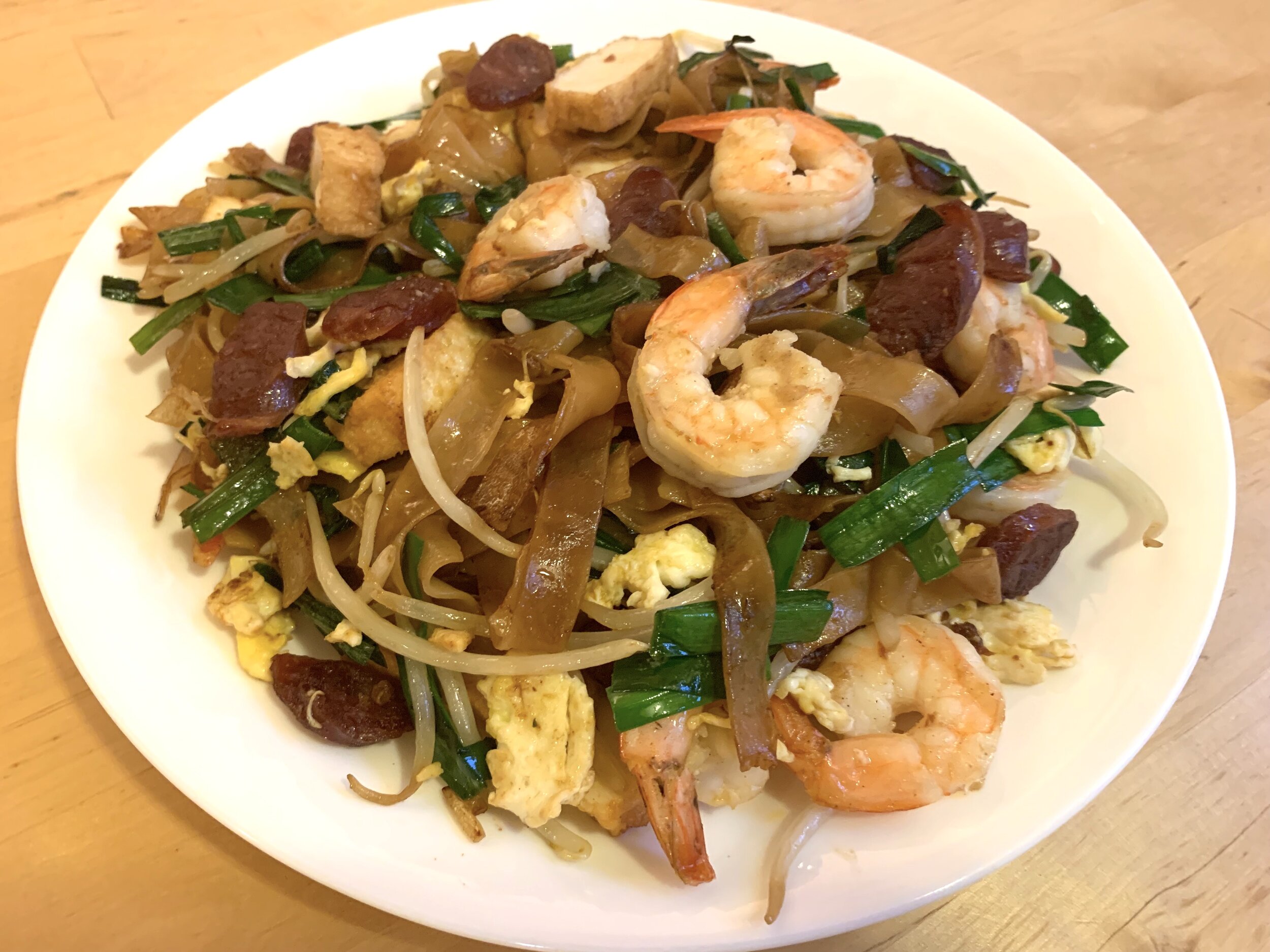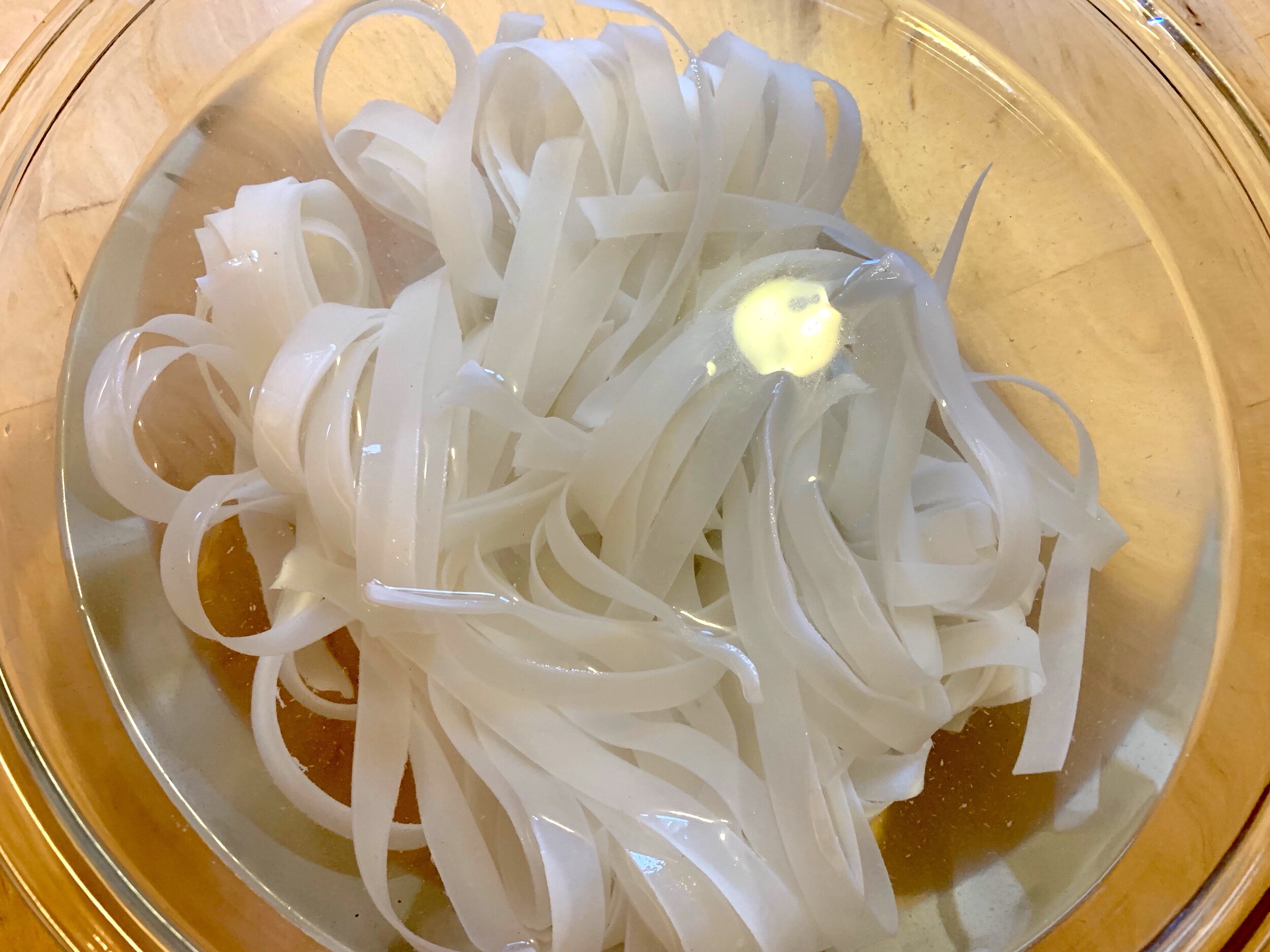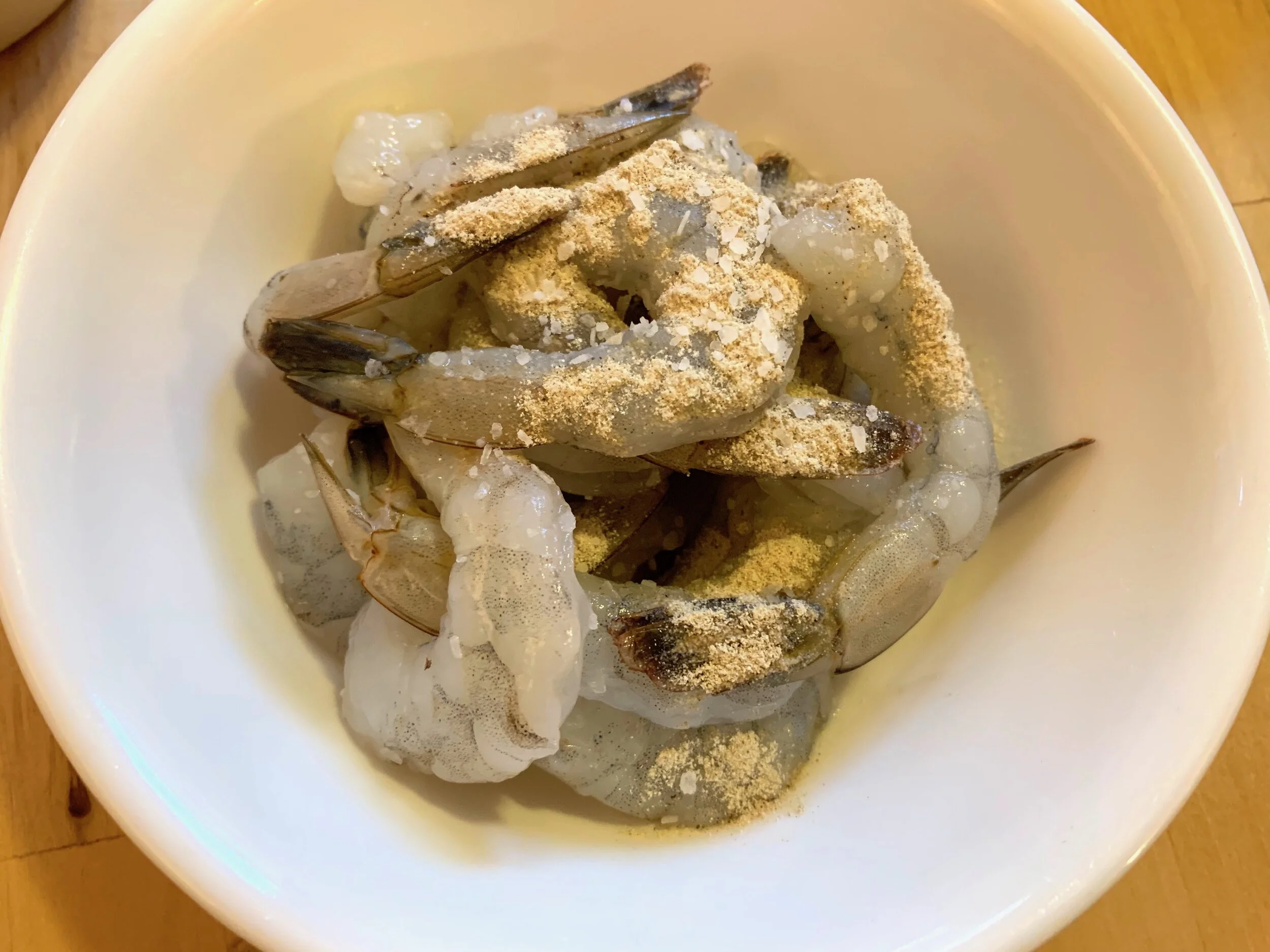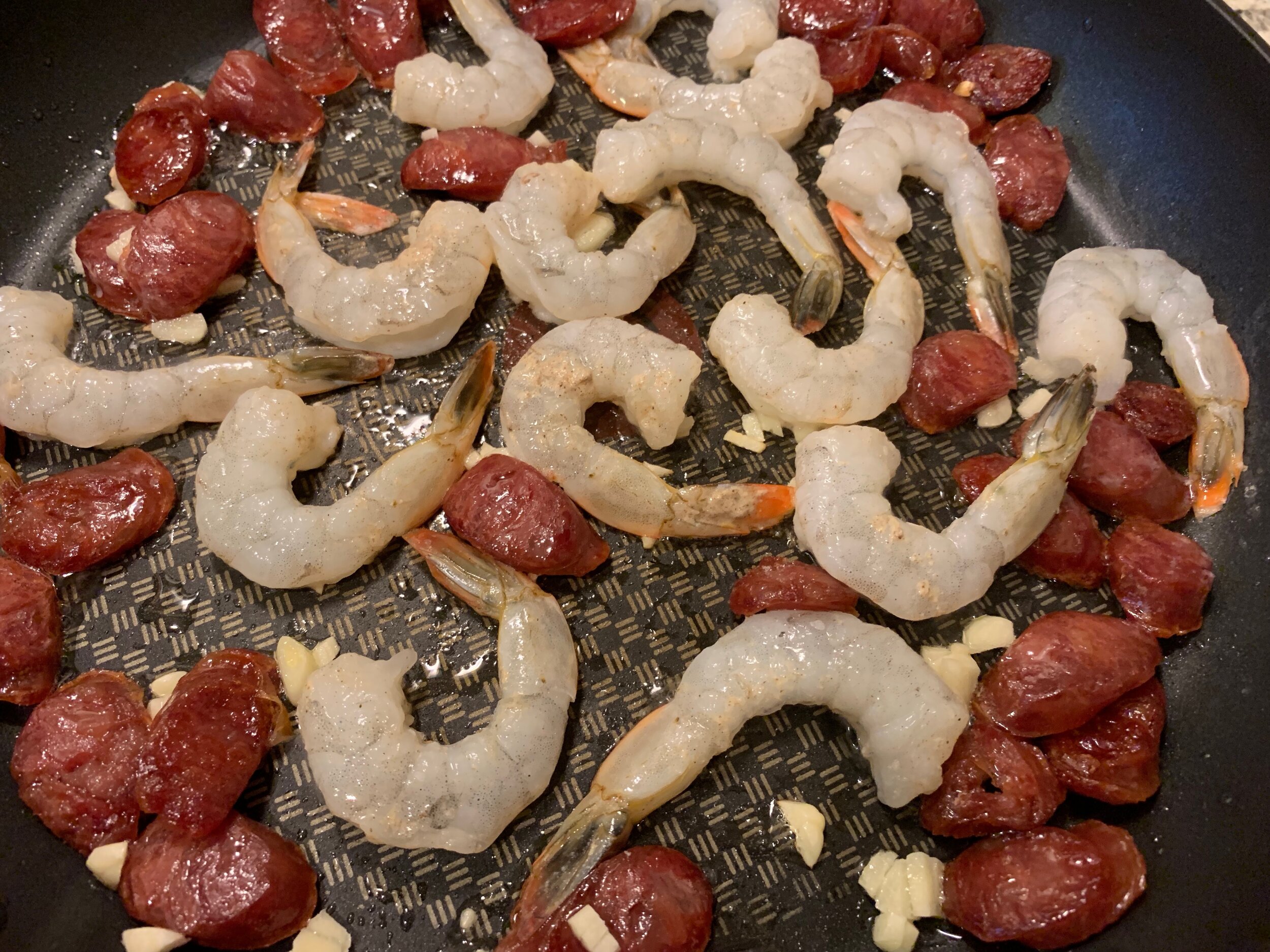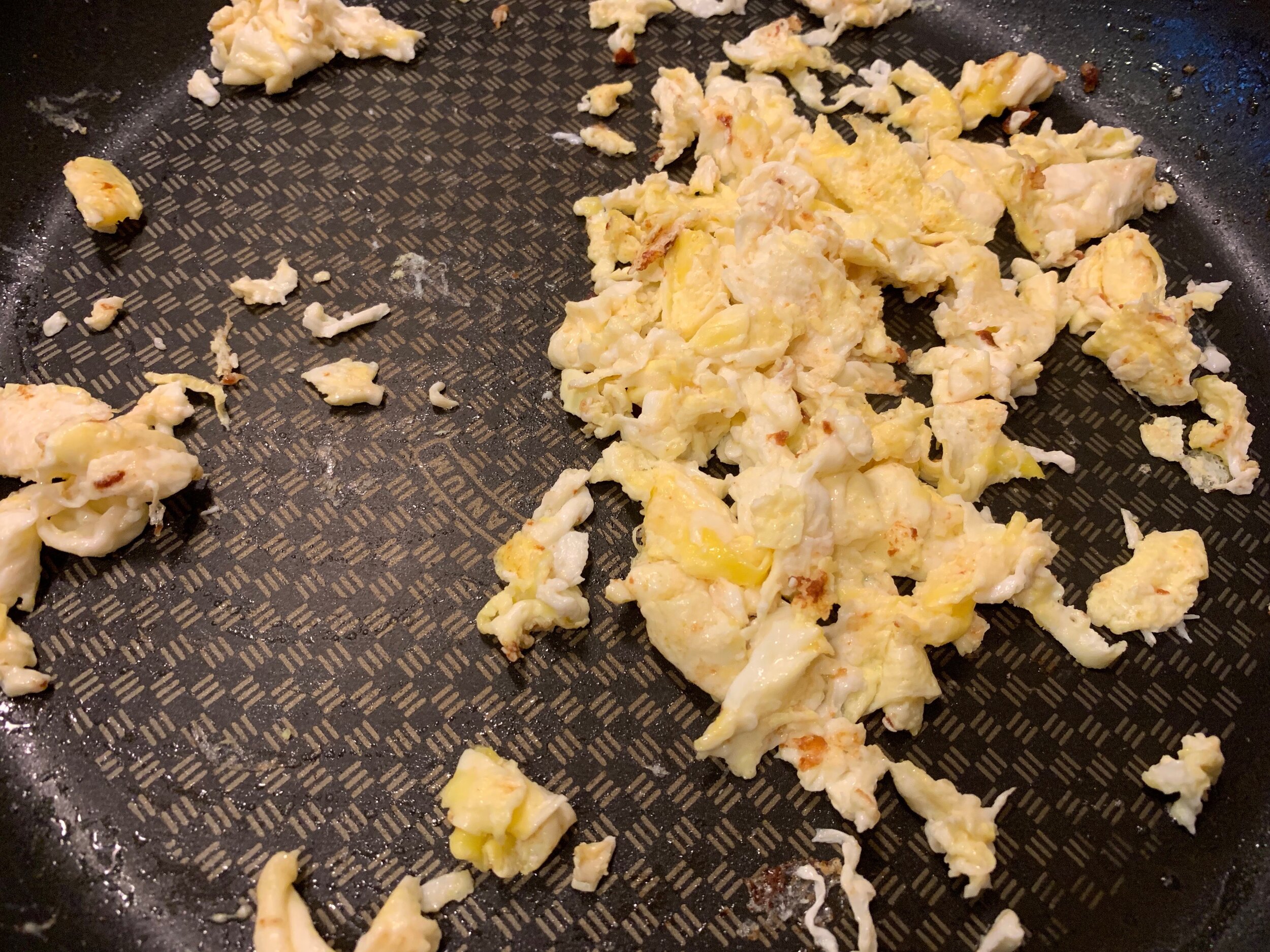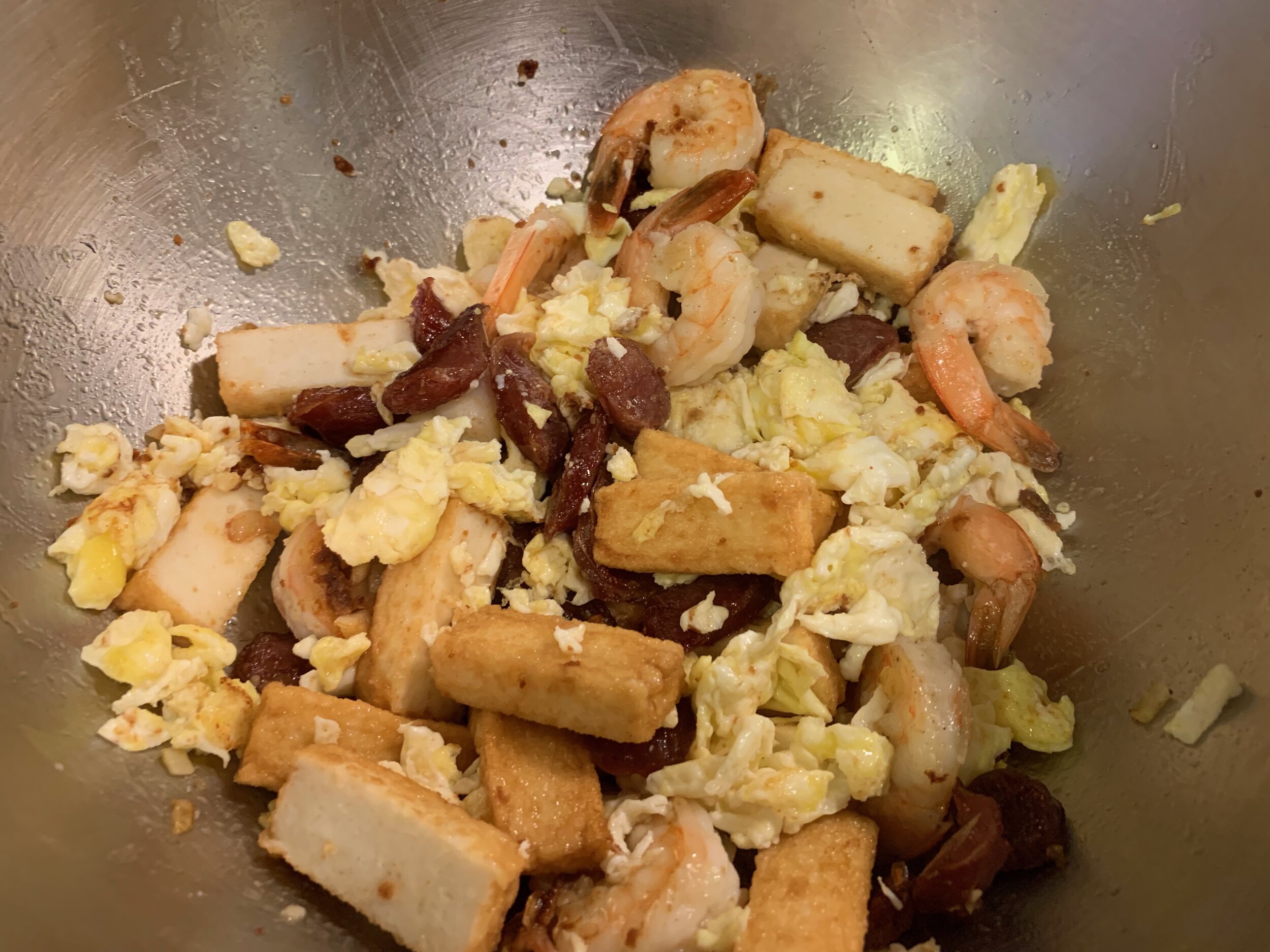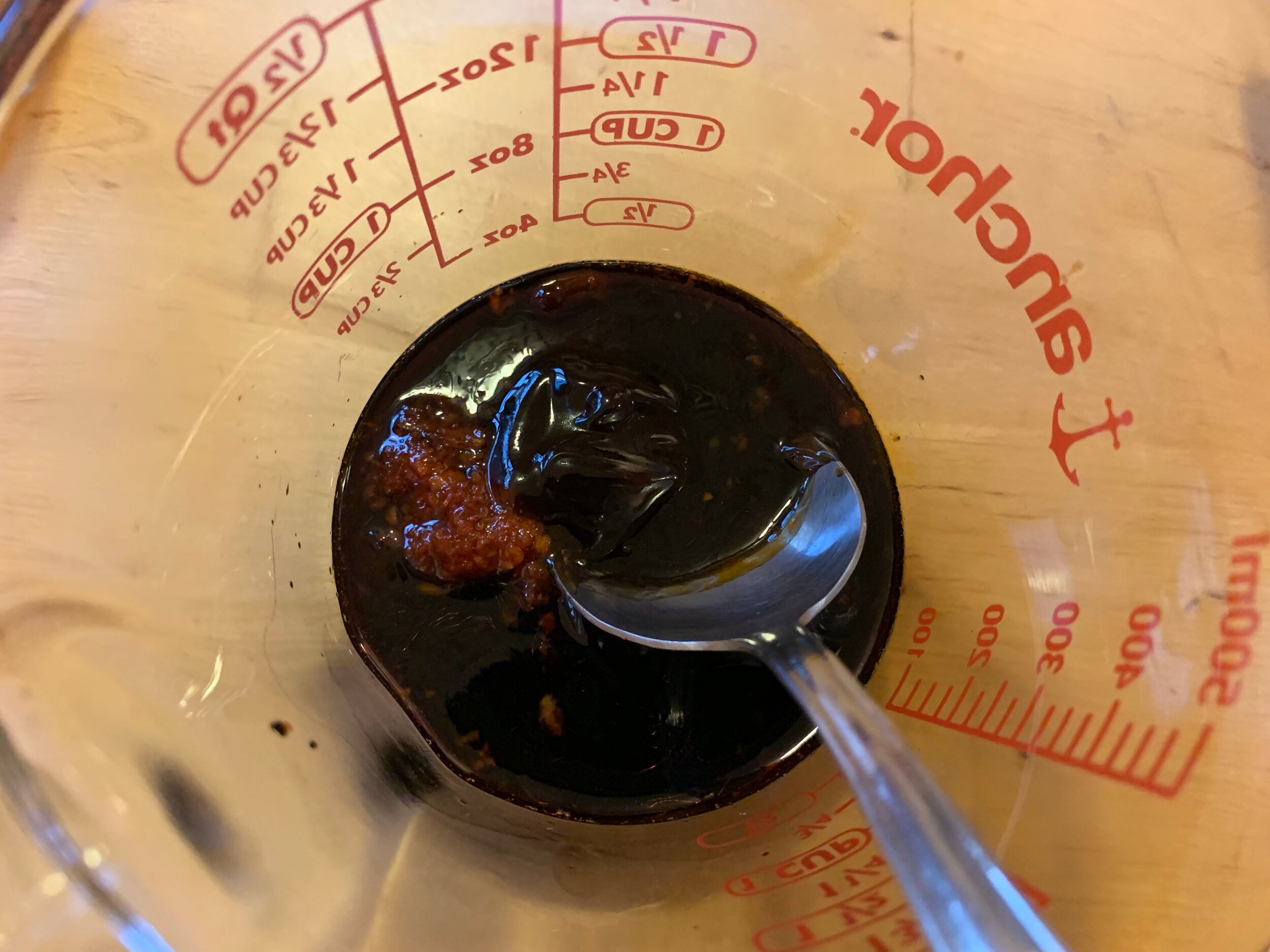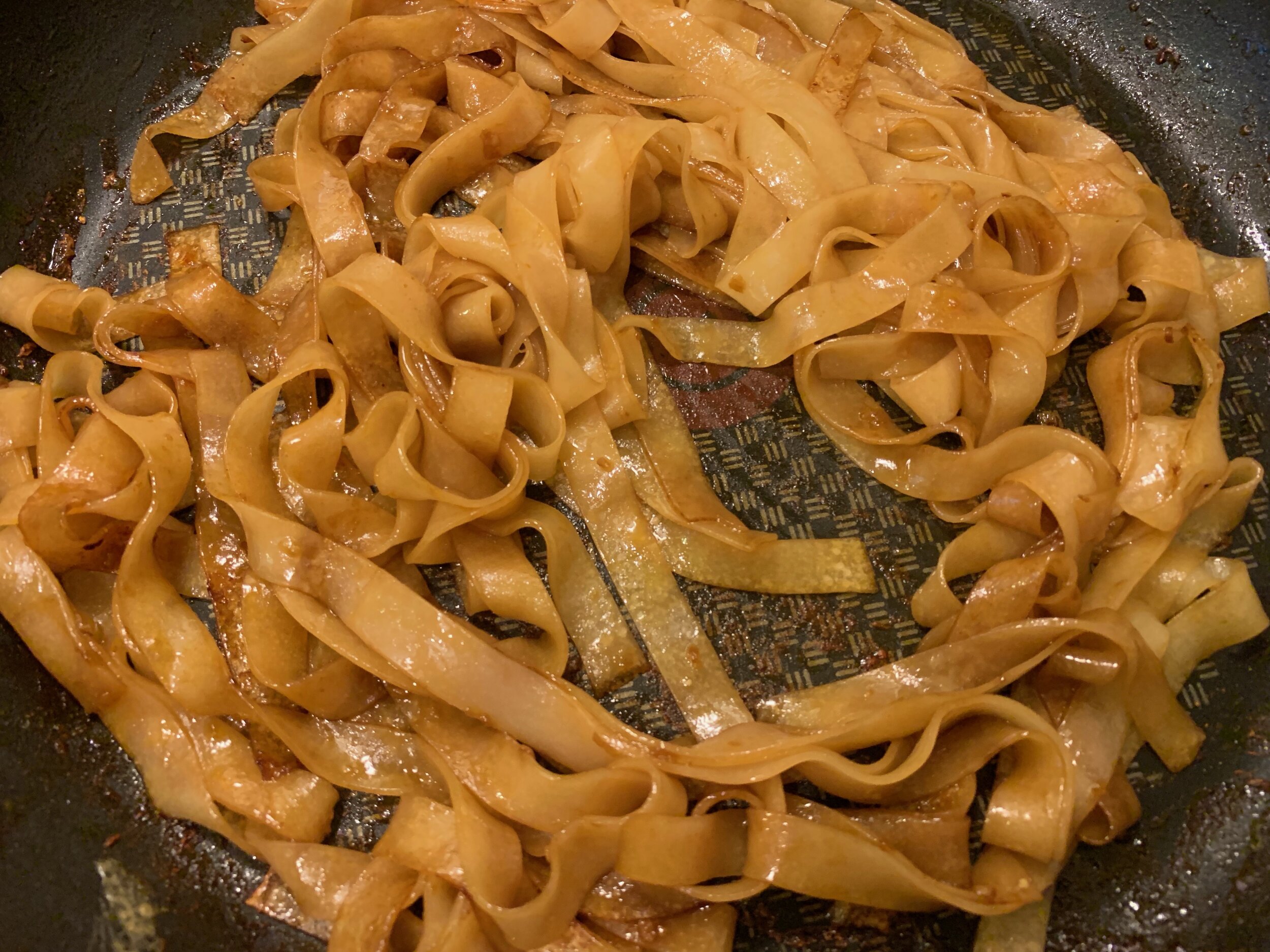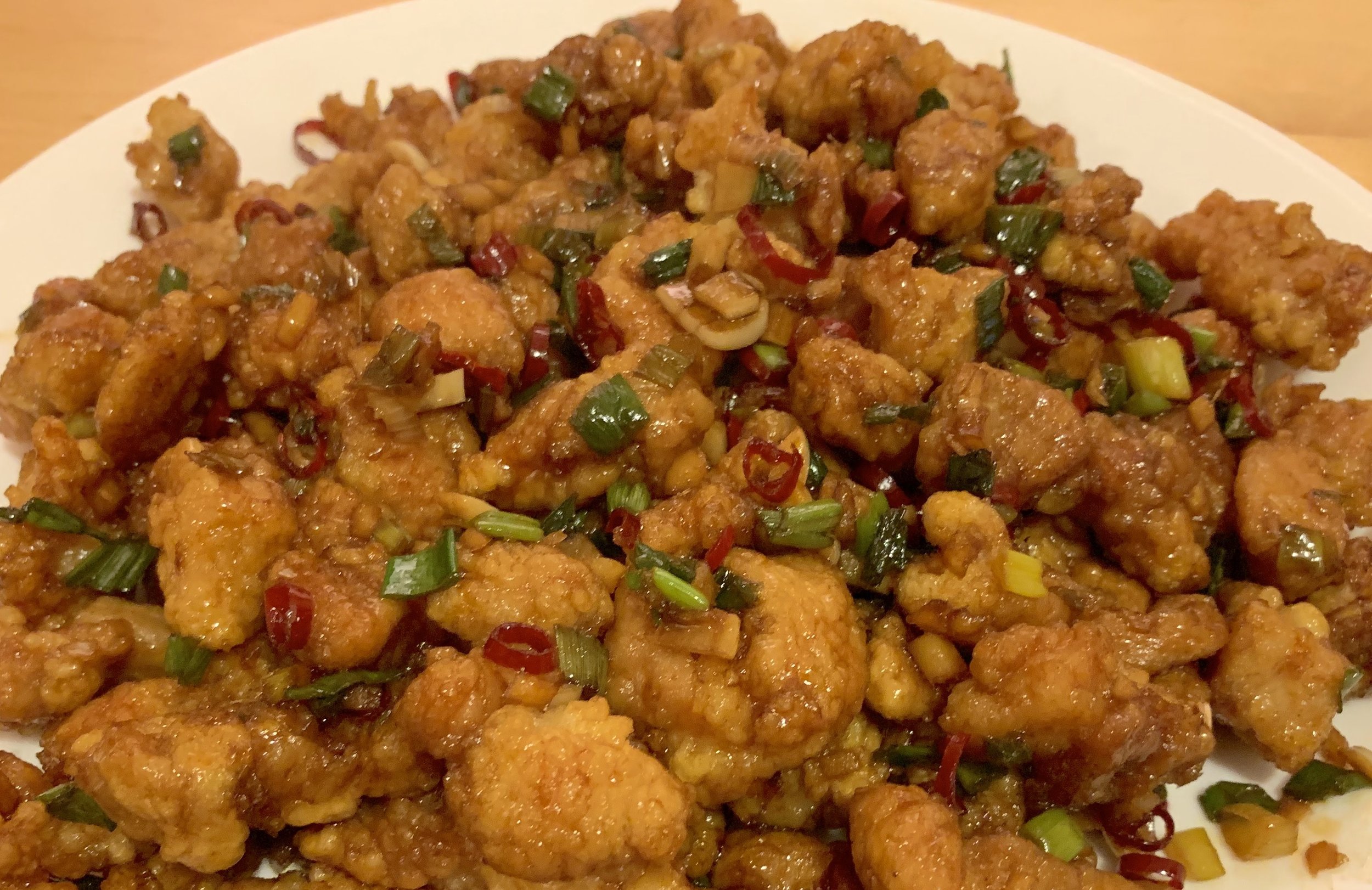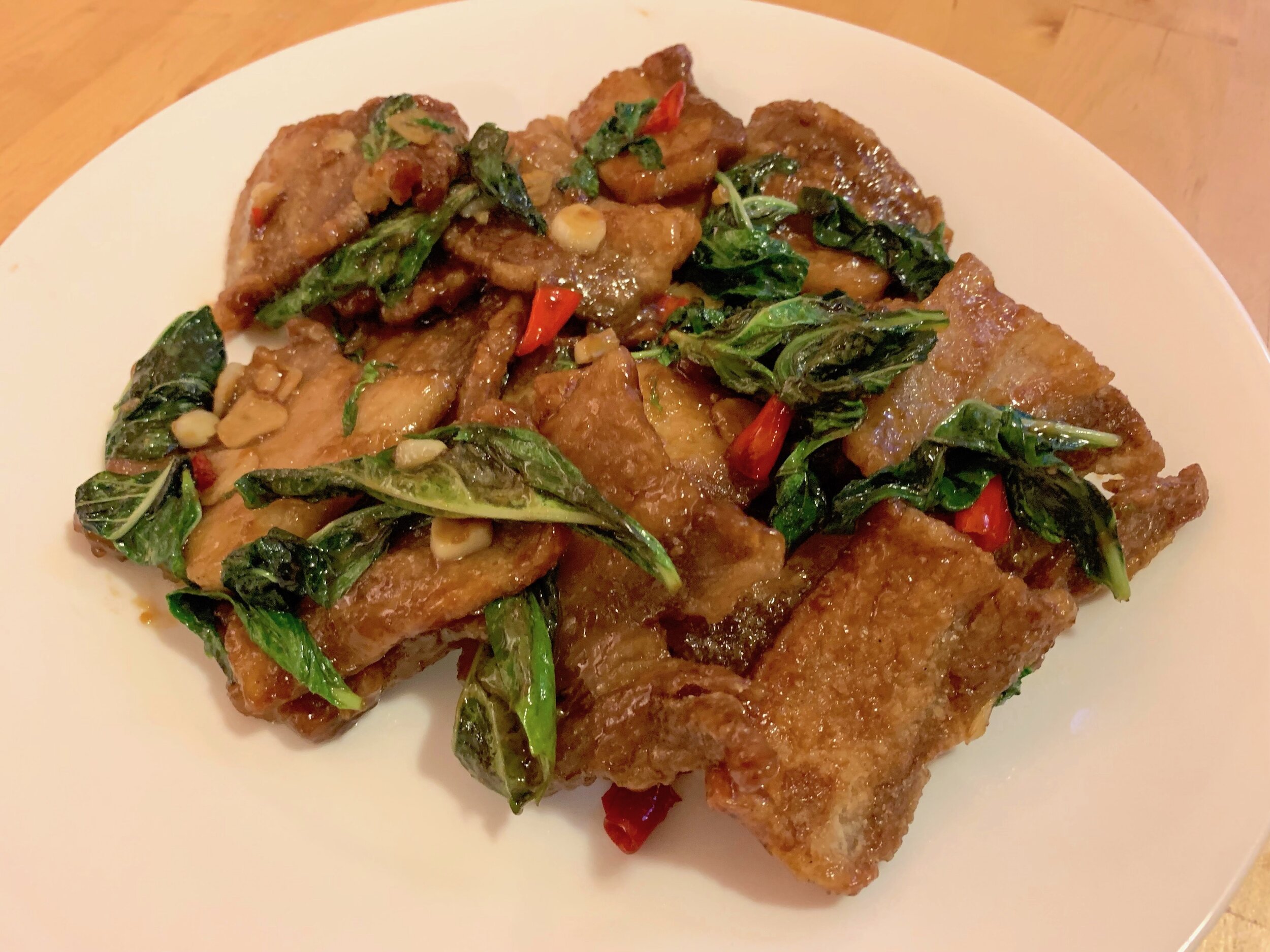Char Kway Teow
炒粿條 (Cha Koe Tiau)
Char kway teow is a noodle dish packed with seafood and flavorful ingredients. The dish likely originated with Chinese immigrants to the Malay Peninsula, many of whom worked as fishermen. The result was a humble and hearty dish built on soy sauce and rice noodles, with a Hokkien name (炒粿條) and Chinese ingredients such as sausages and garlic chives, combined with local fish, shrimp, and shrimp paste. Today, char kway teow is commonly found in both Malaysia and Singapore, countries which share much cultural and culinary heritage.[1]
Ingredients
8 oz broad rice noodles
½ lb shrimp
2 Chinese sausages
5 oz fish tofu
2 eggs
6 oz mung bean sprouts
6 oz garlic chives
2 cloves garlic, minced
½ tsp salt
¼ tsp white pepper
2 tsp soy sauce
2 tsp dark soy sauce
1 tbsp oyster sauce
1 tsp shrimp paste
1 tsp sugar
Vegetable oil
You can use either fresh or dried broad rice noodles for this dish, though dried rice noodles are far more widely available.[2] Dried rice noodles must be rehydrated before use. Soak the noodles in hot (just boiled) water for 30 to 40 minutes, or until they are soft and pliable. Depending on the brand of the noodles and their thickness, you may have to soak the noodles for longer.
Peel and devein the shrimp, and toss them with ½ teaspoon salt and ¼ tsp white pepper. Set the shrimp aside until you are ready to cook with them. As the stir-fry will move pretty quickly, we will also take this opportunity to do the rest of our mise en place. Cut the Chinese sausages on the bias into ¼ inch slices. Wash and drain the vegetables, and chop the garlic chives into 1 inch pieces. This dish also calls for fish tofu. Fish tofu is a type of fishcake, made from whitefish paste and steamed. It has a texture similar to tofu, but contains no soy products. You can find fish tofu in the frozen section of most Asian grocery stores. Thaw it out, and cut into ¼ inch slices.
Traditionally, the ingredients for char kway teow are cooked in pork fat, which we will render this fat from the Chinese sausages. Add the sausages to a cold pan and cook over low heat, tossing occasionally, until the fat renders and the sausage begins to crisp, about 5 minutes. Then turn the heat up to high, add the minced garlic, and fry for about 30 seconds until the garlic is fragrant.
When the pan is hot, add the shrimp in a single layer, making sure each shrimp has direct contact with the pan. We will sear the shrimp for about 1 minute per side, flipping just once, until the shrimp are just cooked through (This cook time is intended for shrimp in the 40-50 count per pound size range. If your shrimp are smaller or larger than this, adjust the cook time accordingly).
Next, add the sliced fish tofu to the pan. Toss the ingredients until the fish tofu is warmed through. Remove the mixture of sausage, shrimp, and fish tofu from the heat, and place it in a heatproof bowl.
Next up are the eggs [3]. Add a bit more vegetable oil if needed, then add the two beaten eggs to the pan. Scramble the eggs, breaking them up into small pieces. When the eggs are cooked, remove them from the heat and add them to the protein mixture.
When the noodles are sufficiently softened, drain them well. Prepare the sauce by combining the soy sauce, dark soy sauce, oyster sauce, shrimp paste, and sugar. Shrimp paste is a common Southeast Asian ingredient, which consists of finely crushed shrimp which has been salted and fermented. It has a pungent aroma and a distinct savory flavor, and can be found in most Asian supermarkets, either brick form or oil-packed. Mix the sauce well, and set aside. Now we are finally ready to bring the multiple elements of this dish together! As with other noodle stir-fries, it is important that we maintain dry heat. If we add all the noodles at once to the pan, we risk boiling the noodles instead, so unless you have a very large pan or wok, I’d recommend doing the final stir-fry in two batches. If you’re feeling particularly ambitious, you can do both batches simultaneously using two burners and two pans. However, I’d recommend starting with just one batch at a time.
For one batch, heat 1 tablespoon of vegetable oil over high heat. When it’s hot, add half of the drained noodles. Pour over half of the sauce, and toss gently. Broad rice noodles are relatively fragile, so do your best not to break too many noodles when tossing [4]. Cook, moving constantly, until the noodles are uniformly coated in sauce and begin to color and char, about 2 to 3 minutes.
Add half of the chives and half of the mung bean sprouts to the pan. Cook for 2 more minutes, tossing with the noodles, until the chives begin to wilt. Then add half of the reserved sausage, shrimp, tofu, and egg mixture to the pan, and toss gently to combine, cooking for an additional minute until everything is warmed through. Plate the finished dish, and repeat these steps for the second batch. Serve the noodles hot![5]
Substitutions
If you can’t find fish tofu, you can substitute other Asian fishcakes, or you can use fried tofu or tofu puffs. Other types of seafood commonly used in this dish include squid or cockles. You can also substitute the Chinese sausage for char siu pork. If you don’t like garlic chives, you can substitute scallions or onions.
[1] The Malay Peninsula was brought under British dominion in the early 1800s. To secure their position in the Southeast Pacific, the British founded the city of Singapore on the tip of the peninsula, which grew into a wealthy port city and trading hub. In the aftermath of the Second World War and as part of the United Kingdom’s rapid decolonization, most of British Malaya was granted independence in 1957, forming the Federation of Malaya. However, Singapore remained under British administration for several more years. In 1963, the administration of the Crown Colonies of Singapore, North Borneo, and Sarawak were transferred to the Federation, forming the modern state of Malaysia. However, the merger of Malaya and Singapore proved a rocky one. There were fears in the Malaysian government that Singapore’s large, wealthy, and predominantly ethnically Chinese population could outvote the ethnically Malay population of the country, and that Singapore’s economic strength would tip the balance of power away from Kuala Lumpur. In Singapore, there was apprehension that the Malaysian government’s affirmative action policies and state religion would be imposed upon the city. These tensions were not helped by their Indonesian neighbors, who feared the rise of a united Malaysia and conducted a series of covert operations intended to provoke conflict between the Malays and Chinese, including a series of bombings carried out by Indonesian commandos. The political situation eventually boiled over in a series of race riots in Singapore in 1964. In a bid to end the violence, the Malaysian Parliament voted to expel Singapore from Malaysia, making Singapore the only country in history to gain its independence unwillingly. Ironically, the violent separation of the two nations caused both governments to reexamine their handling of ethnic conflicts. Today, both Singapore and Malaysia place a great deal of emphasis on their multicultural heritage. The neighbors retain close economic ties, and are both members of ASEAN.
[2] In parts of Eastern Malaysia, sliced rice cakes are commonly used instead of rice noodles.
[3] With a traditional wok, the method is to push the meat and vegetables to the edge of the wok, where the heat is low, and to fry the egg in the center. However, this method is not very effective in a pan—it is better to work in series.
[4] If you find when cooking that the noodles are insufficiently softened, you can recover by adding a tablespoon of water to the pan and covering, letting the noodles steam until softened.
[5] Char kway teow is often served on a banana leafs, which lends the dish some additional fragrance.
Recipe
Prep Time: 15 min Cook Time: 20 min Total Time: 45 min
(+10 min inactive)
Difficulty: 3/5
Heat Sources: 1 burner
Equipment: large pan or wok
Servings: 6
Ingredients
8 oz broad rice noodles
½ lb shrimp
2 Chinese sausages
5 oz fish tofu
2 eggs
6 oz mung bean sprouts
6 oz garlic chives
2 cloves garlic, minced
½ tsp salt
¼ tsp white pepper
2 tsp soy sauce
2 tsp dark soy sauce
1 tbsp oyster sauce
1 tsp shrimp paste
1 tsp sugar
Vegetable oil
Instructions
1. Soak the dried rice noodles in hot water for 30-40 minutes, or until soft. When the noodles are pliable, drain the noodles well.
2. Toss the shrimp with ½ tsp salt and ¼ tsp white pepper and set aside. Cut the Chinese sausages and fish tofu into ¼ inch slices, and chop the garlic chives into 1 inch pieces.
3. Add the Chinese sausages to a cold pan. Cook over low heat until the fat renders and the sausage begins to crisp, about 5 minutes.
4. Turn the heat up to high, add the minced garlic, and fry until fragrant, about 30 seconds.
5. Add the shrimp to the pan in a single layer. Fry the shrimp for about 1 minute per side, flipping once, until the shrimp are just cooked through.
6. Add the fish tofu slices to the pan and toss with the other ingredients until the fish tofu is warmed through. Remove the shrimp, sausages, and tofu from the heat and set aside.
7. Add additional vegetable oil to the pan, then pour in two beaten eggs. Scramble the eggs, and add the cooked eggs to the protein mixture.
8. In a bowl, mix together the soy sauce, dark soy sauce, oyster sauce, shrimp paste, and sugar to make the sauce.
9. Bring together the dish in two batches (unless you have a very large wok). Heat 1 tbsp vegetable oil to the pan over high heat, and add half of the softened rice noodles. Add half of the sauce and toss gently, coating the noodles in the sauce. Cook for 2-3 min, tossing occasionally, until the noodles color and just char.
10. Add half of the chopped chives and half of the mung bean sprouts to the pan. Stir fry for 2 minutes, or until the chives begin to wilt.
11. Return half of the protein mixture to the pan, toss to combine, and cook for an additional minute.
12. Remove from the heat and serve. Repeat steps 9 through 11 for the second batch.
